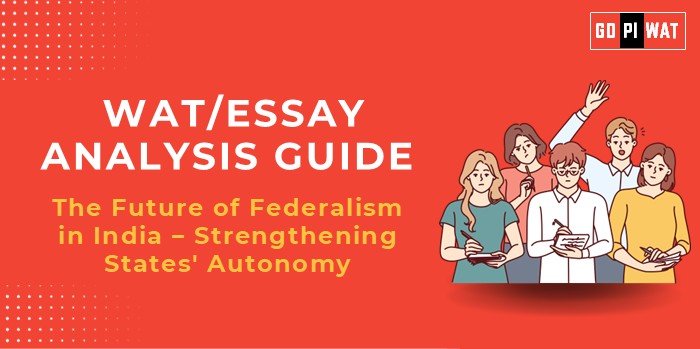📋 WAT/Essay Analysis Guide
🌟 Topic: The Future of Federalism in India – Strengthening States’ Autonomy
📖 Understanding the Topic’s Importance
India’s federal structure balances central coordination with state autonomy, critical for managing the country’s diverse regional needs. Strengthening states’ powers is pivotal for fostering regional innovation, reducing disparities, and ensuring efficient governance. This topic aligns with themes like policy innovation and decentralized administration, which are crucial for management professionals.
🕒 Effective Planning and Writing
- Time Allocation:
- Planning: 5 minutes
- Writing: 20 minutes
- Review: 5 minutes
- Preparation Tips:
- Research fiscal devolution trends, especially the 15th Finance Commission’s impact on states’ autonomy.
- Identify key conflicts, such as GST disputes or legal tussles like the Delhi government vs. Centre case, to use as examples.
✍️ Structuring the Essay
📜 Introduction Techniques:
- Contrast Approach: “While central schemes promote uniform development, limited state autonomy often results in inefficiencies and unaddressed local priorities.”
- Timeline Approach: “From the Sarkaria Commission in 1983 to recent GST reforms, India’s federal journey reflects evolving dynamics in central-state relations.”
📊 Body Paragraphs:
🏆 Achievements:
- Fiscal devolution (e.g., 41% tax pool allocation by the 15th Finance Commission).
- State-led innovations in health and education (e.g., Kerala’s healthcare model).
- GST’s role in simplifying taxation and promoting economic integration.
⚠️ Challenges:
- Revenue allocation tensions (e.g., southern states contributing more but receiving less).
- Political disputes limiting collaborative governance.
- Rural-urban inequities, where policies inadequately address regional needs.
🔮 Future Outlook:
- Build frameworks for enhanced fiscal autonomy (e.g., performance-based funding).
- Strengthen inter-governmental councils like the Inter-State Council for policy harmonization.
- Learn from global models like Germany’s cooperative federalism.
🏁 Conclusion Templates
- Balanced Perspective: “Strengthening state autonomy within a robust national framework ensures equitable governance while upholding national unity.”
- Global Comparison: “India can draw inspiration from Germany’s cooperative federalism to empower states while maintaining cohesion through constitutional clarity and fiscal equity.”
✨ Recommendations for Sustainable Progress
- Performance-Based Fiscal Models: Tie funding to measurable outcomes, ensuring states can manage resources effectively.
- Concurrent Policy Participation: Enhance state roles in subjects like education and health for better regional outcomes.
- Strengthen the Inter-State Council: Encourage regular dialogue to resolve policy disputes and align developmental priorities.
📄 Sample Short Essays
1. Balanced Perspective:
“India’s federalism thrives on balancing state autonomy with national unity. By recalibrating fiscal policies and fostering cooperative mechanisms, the nation can ensure sustainable growth across its diverse regions.”
2. Solution-Oriented:
“Empowering states with fiscal autonomy and policy-making freedom can address regional disparities while reinforcing India’s federal ethos, setting the stage for inclusive development.”
3. Global Comparison:
“Learning from Germany’s cooperative federalism model, India can harmonize central and state objectives, ensuring inclusive governance and strengthening its democratic fabric.”


